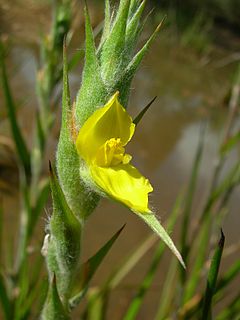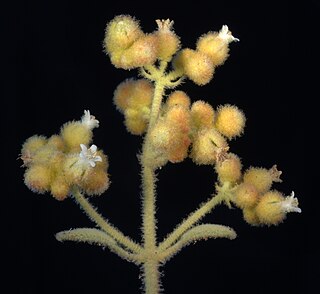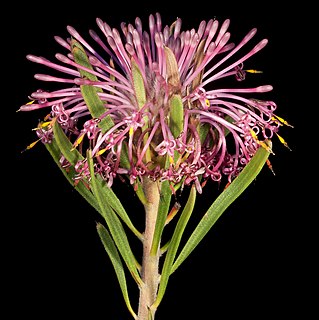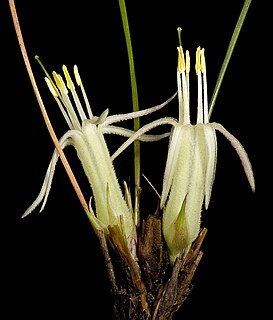
Banksia meisneri, commonly known as Meisner's banksia, is a shrub that is endemic to a small area in the south-west of Western Australia. It has crowded, more or less linear leaves and in winter and spring, spikes of golden brown flowers followed by furry fruit which usually only open after fire.

Banksia acanthopoda is a species of shrub in the family Proteaceae. It grows as a small spreading shrub to 2 m high and has prickly leaves and yellow composite flower heads, called inflorescences, composed of 50 to 60 individual yellow flowers. Flowering takes place in the southern hemisphere winter. Endemic to Western Australia, it occurs only in a few populations in the vicinities of Woodanilling, Katanning and Darkan. Because of its rarity, it is classed as "Priority Two" conservation flora by Western Australia's Department of Environment and Conservation.

Calectasia is a genus of about fifteen species of flowering plants in the family Dasypogonaceae and is endemic to south-western Australia. Plants is this genus are small, erect shrubs with branched stems covered by leaf sheaths. The flowers are star-shaped, lilac-blue to purple and arranged singly on the ends of short branchlets.

Comesperma is a genus of shrubs, herbs and lianas in the family Polygalaceae. The genus is endemic to Australia. It was defined by the French botanist Jacques Labillardière in his 1806 work Novae Hollandiae Plantarum Specimen. The genus name is derived from the Ancient Greek words come ("hair") and sperma ("seed"), and relates to the seeds bearing tufts of hair. The genus is distributed over southern Australia, particularly in the southwest of Western Australia, where 19 species are found. 24 species have been described.

Aphanopetalum is a genus of twining shrubs or vines in the family Aphanopetalaceae which are endemic to Australia.

Adenanthos obovatus, commonly known as basket flower, or, jugflower, is a shrub of the plant family Proteaceae endemic to Southwest Australia. Described by French naturalist Jacques Labillardière in 1805, it had first been collected by Archibald Menzies in 1791. Within the genus Adenanthos, it lies in the section Eurylaema and is most closely related to A. barbiger. A. obovatus has hybridized with A. detmoldii to produce the hybrid A. × pamela. Several common names allude to the prominent red flowers of the species. It grows as a many-stemmed spreading bush up to 1 m (3.3 ft) high, and about 1.5 m (4.9 ft) across, with fine bright green foliage. Made up of single red flowers, the inflorescences appear from April to December, and peak in spring.

Laxmannia is a genus of tufted perennial herbs in the family Asparagaceae, subfamily Lomandroideae, that are endemic to Australia.
Melaleuca keigheryi is a shrub in the myrtle family, Myrtaceae with white, papery bark and is endemic to the west coast of Western Australia. In spring, it has heads of pink flowers which fade in color to become white.

Adenanthos macropodianus, commonly known as gland flower, or Kangaroo Island gland flower, is a species of shrub in the family Proteaceae. It is endemic to Kangaroo Island in South Australia. First published as a variety of A. sericeus in 1870, it was promoted to species rank in 1978.

Philydrum is a genus of tufted, herbaceous, aquatic macrophyte plants, one of three genera constituting the plant family Philydraceae.

Grevillea maccutcheonii, commonly known as McCutcheon's grevillea, is a rare shrub in the family Proteaceae. It is endemic to south-western Western Australia, where only 7 mature plants remain in the wild. It usually grows to 2 metres in height and width The distinctively-shaped leaves are stem clasping with 3 rounded lobes, each tipped with a spine. The flowers, which have a reddish green perianth and a red style, appear predominantly between July and November in the species' native range, but may appear sporadically throughout the year.

Melastoma malabathricum, known also as Malabar melastome, Indian rhododendron, Singapore rhododendron, planter's rhododendron and senduduk, is a flowering plant in the family Melastomataceae. This plant is native to Indomalaya, Japan and Australia, and is usually found between 100 and 2,800 m on grasslands and sparse forests. It has been used as a medicinal plant in certain parts of the world, but has been declared a noxious weed in the United States. M. malabathricum is a known hyperaccumulator of aluminium, and as such can be used for phytoremediation.

Johnsonia is a genus five species of herbs in the family Asphodelaceae, all of which are endemic to the south-west of Western Australia. They are grass-like plants with minute flowers surrounded by bracts which are often tinged with white, pink or cream.

Johnsonia pubescens, commonly called the pipe lily, is a grass-like plant in the family Asphodelaceae, subfamily Hemerocallidoideae, endemic to the south-west of Western Australia. As with others in the genus, it is distinguished by its minute flowers which are on the end of a spike and hidden by large, overlapping, papery bracts.
Gregory John Keighery is an Australian botanist. Since 2003 he has been a senior research scientist at the Science and Conservation Division of the Department of Biodiversity, Conservation and Attractions of Western Australia. His main expertise is in the native plants of Western Australia, particularly weed flora and the Apiaceae, Liliaceae and Myrtaceae.

Dicrastylis exsuccosa is a species of plant within the genus, Dicrastylis, in the family Lamiaceae. It is endemic to inland Australia and found in Western Australia, the Northern Territory and South Australia.

Isopogon longifolius is a small shrub in the family Proteaceae that is endemic to the southwest of Western Australia.

Isopogon linearis is a small shrub in the family Proteaceae that is endemic to the southwest of Western Australia.

Macarthuriaceae is a family of plants in the order Caryophyllales and consists of a single genus, Macarthuria.

Conostylis androstemma is a tufted perennial plant species in the family Haemodoraceae. It is endemic to the south-west of Western Australia. Plants grow to between 10 and 30 cm high and produce cream to pale yellow flowers between May and August in the species' native range.

















